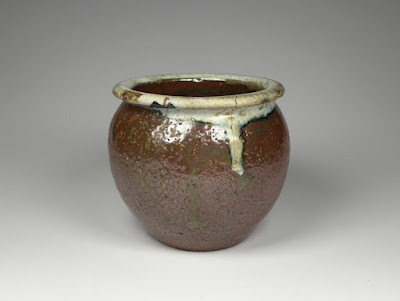仙北地方の小さなかめ Small Pots from Senboku Region
19世紀に秋田県仙北地方の白岩か楢岡あたりで焼かれたと考えられる小さなかめ(甕)を3つほど手に入れた。
I obtained three small earthenware pots that were probably from the 19th-century Shiraiwa or Naraoka potteries in the Senboku Region, Akita prefecture, Japan.
1個目
全体が丸っこくて、口がちょっと外向きに立ち上がる、独特の形をしたかめ。落ち着いた光沢の鉄釉(泥釉)の上には青みを帯びた白色のなまこ釉がかかっていて、この色合いも独特だ。高台の細工もていねいで、大きさの割には手間がかかっているとおもう。たぶん幕末から明治初期の白岩焼だとおもうが、もしそうだとすると、これはもう単なる雑器の一言では片付けられない、古白岩の逸品と言ってもいいのではなかろうか。
This round-shaped pot has a distinct top rim that stands a bit outward. The glaze's color over a brown coating is subtly bluish white, which would be especially outstanding. The work on the bottom part shows a delicate workmanship. This was merely a small daily-use earthenware, but I presume it would be one of the masterpieces of old Shiraiwa ware, if my estimation of this pot's origin is correct.
2個目
1個目よりひとまわり小さい豆かめ。この手のかめとしては最小サイズだろう。鉄釉はテカテカしていて、口べりのなまこ釉はじゃっかん緑がかったクリーム色にみえる。高台はおなじく碁笥底タイプ。大きなキズがあるが、前の所持者が補修している。
The size is probably the smallest among this kind of earthenware pots. The brown coating is more lustrous, and the white glaze is slightly greenish. The bottom part is almost same in shape as the previous one. The former owner has made repairs.
3個目
形状は1個目や2個目のかめと共通するものがある。いっぽうなまこ釉は発色がうまくいかなかったのか、緑がかった透明釉と化している(しずくの部分は白濁している)。それから鉄釉が薄くしかかかっておらず、部分的にはほとんど素焼きに近い。そして底部はまったく施釉されておらず、高台の細工もみられない。したがって底は分厚く、持ったとき重みを感じる。仙北あたりのかめとしては珍品といえる。
The shape is similar to the first and second ones. I guess the glaze's color didn't come out well, so the color looks greenish. The brown underglaze is thin, and the bottom part is totally unglazed without any decoration. The body is so thick that it weighs heavier. I think this is a rare example of earthenware pots in the Senboku region.
考察
これら3点は古物店の主人の弁とわたしのこの2年あまりの経験とを総合すれば、19世紀の白岩焼の可能性が高い。ただ100%そうかと言われると自信がなく、楢岡焼の可能性も捨てきれない。一般には白岩焼は細工が繊細で、小物を多く焼いたといわれるが(宮本康男「白岩焼と楢岡焼」秋田手仕事たより11号、2000年10月、秋田手仕事文化研究会)、 楢岡焼の窯跡からもここで紹介したような高さ 10 cm 以下の豆かめが発掘されている(大仙市文化財調査報告書第15集「楢岡焼」2012年)。また楢岡の土は砂がちでざらついていると言われるので、とくに2個目などは楢岡かもしれない。秋田県内外の他の産地の可能性もゼロとは言えないだろう。
渡辺為吉「白岩瀬戸山」(1933年)によれば、もともと白岩のかめの内側は赤釉(鉄釉)であったが、明治7年(1874年)以降は内側を白釉(なまこ釉)にあらため、同時に値段をあげたとの記録が渡辺家の文書に残っている。この観点でいうと、1個目と2個目は内側は赤釉だが、3個目は内側にも白釉(というかほとんど緑釉)がほどこされており、3個目は比較的に新しい時代の製品かもしれない。器が厚手で高台の削りを省略していることから、この頃になると窯元の経営状態が悪化し、コストカットを余儀なくされたことも想像される。ただそもそもこれらが白岩産ではないかもしれないこと、明治7年の様式変更は基本的に中型から大型のかめについておこなわれた節があること、また渡辺家(ハ窯)以外の白岩の窯では様式がまちまちだった可能性もあること、などから確かなことは言えない。
These three pieces are probably 19th-century Shiraiwa wares, but I can't reject a possibility that some of them were from different potteries such as Naraoka. It is generally said that Shiraiwa tended to produce delicately crafted small earthenwares, while Naraoka made comparatively large rough ones. However, small pots whose size is less than 10 cm have also been found from an abandoned kiln in Naraoka.
Watanabe Tamekichi, a son of Watanabe family who managed a pottery in Shiraiwa, wrote in his book published in 1933 that the glaze inside Shiraiwa pots was red (or brown), but in 1874 it was changed to white (or bluish white) and at the same time the price rose. Looking at three pots shown above, we could recognize from the color that the first and the second pots were made before 1874, and the third one was after 1874. As the latter one is thick and omits the bottom shaping, it could be deduced that Shiraiwa's business was declining at a time after 1874 and a considerable cost-cutting was needed. Of course it is uncertain because Watanabe's description might be applied only to the kiln of Watanabe family, or these small pots might not be produced in Shiraiwa.
番外
首から肩にかけて照りのある鉄釉(泥釉)がかけられるが、胴から底は無釉の豆かめ。糸底で高台の細工はない。秋田の業者から手に入れたので秋田近辺のやきものだとおもうが、産地は判然としない。







